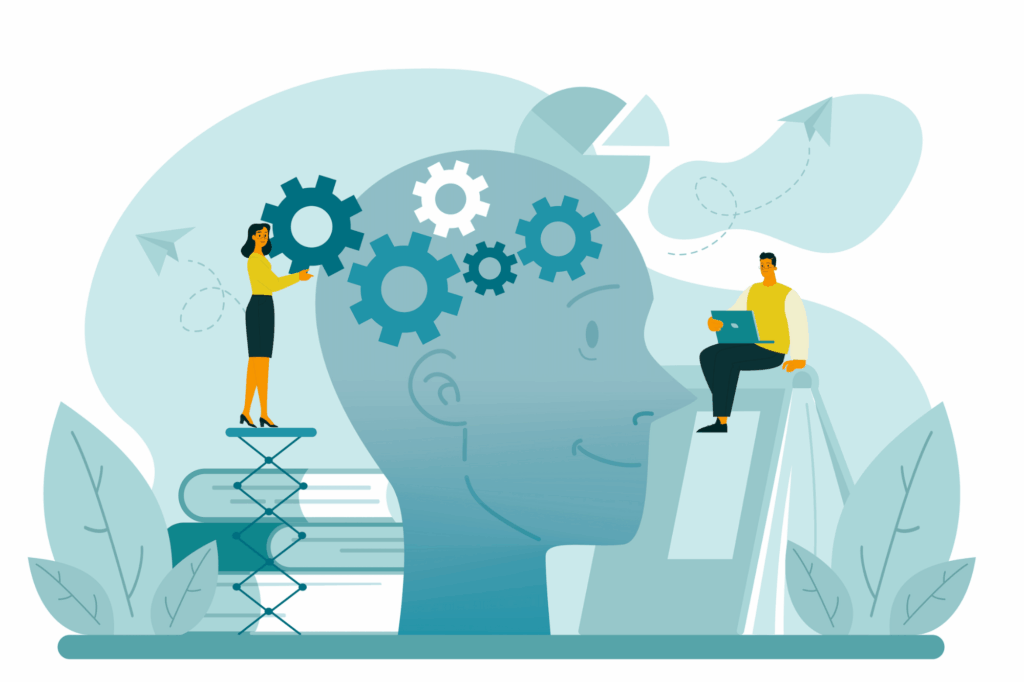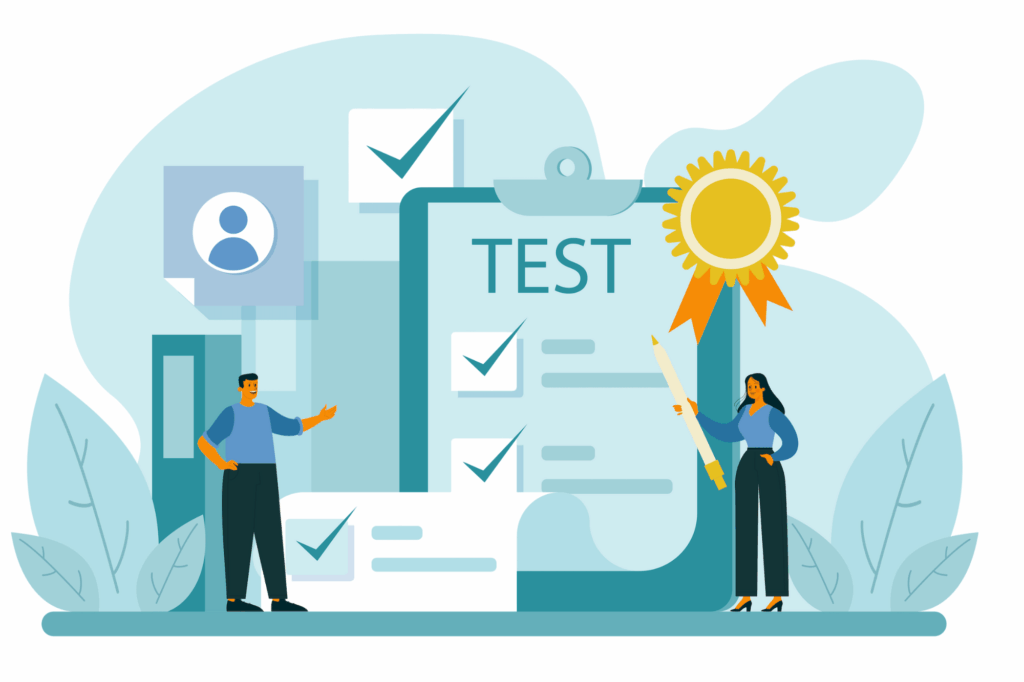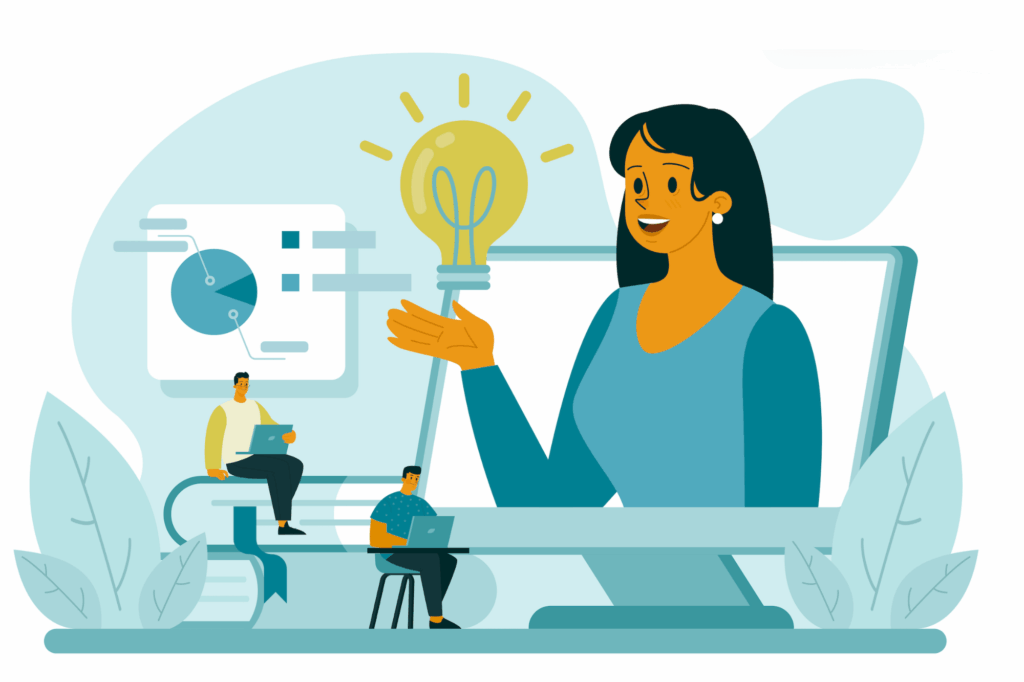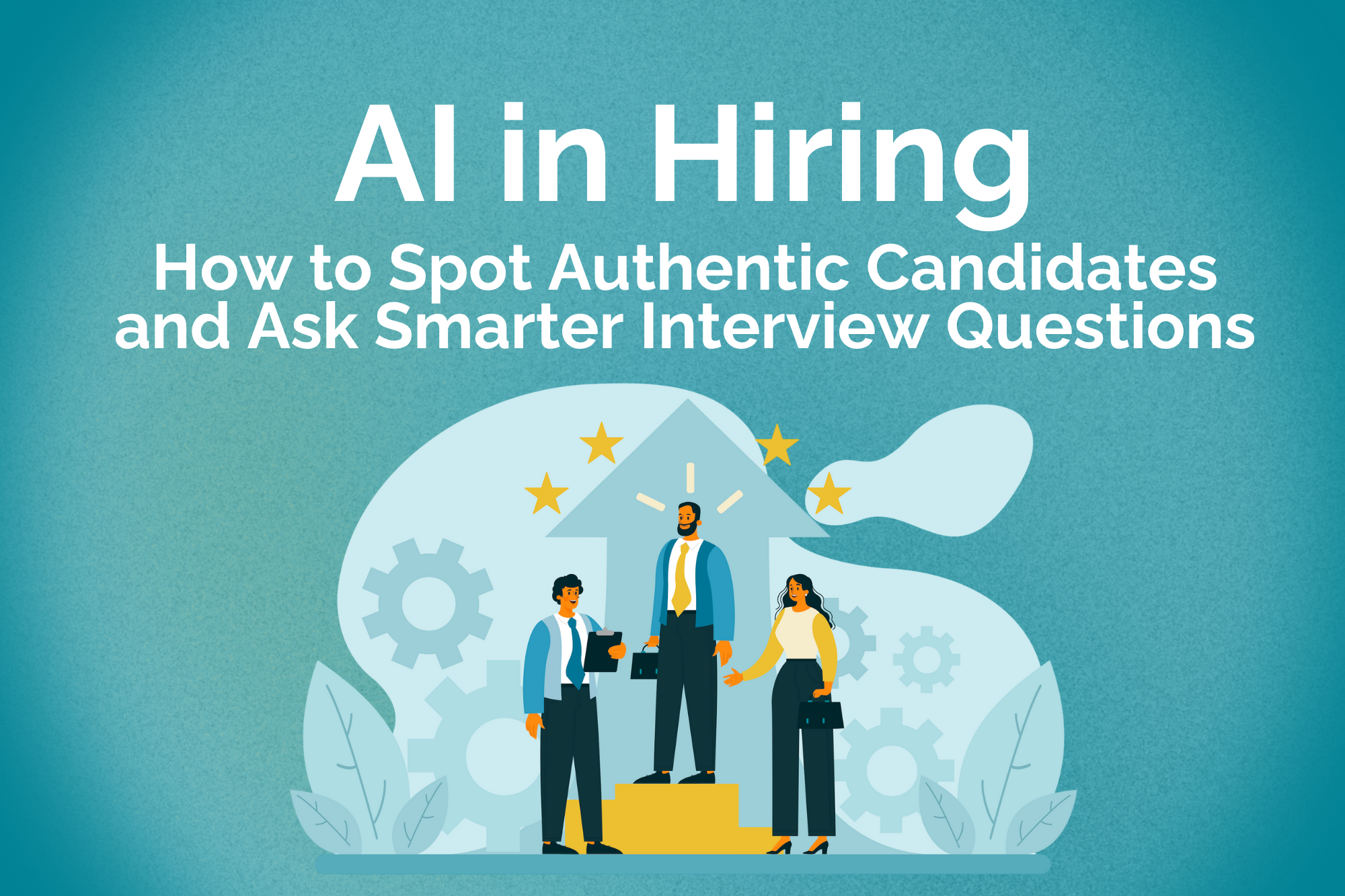Smarter Hiring with AI: Finding Real Talent Through Better Questions
In less than three years, AI in hiring has evolved from a niche experiment into a core recruiting strategy. Today, recruiters use artificial intelligence tools to source, screen, and rank talent, while candidates increasingly rely on AI-powered platforms like ChatGPT, Jasper, and Notion AI to craft resumes, write cover letters, and even generate AI-assisted interview responses. According to the Insight Global’s 2025 AI in Hiring Survey Report, 99% of hiring managers now use AI in recruitment, and nearly half of all job seekers do the same.
This rapid adoption has created a new paradox: greater efficiency but less authenticity. The hiring process has become a dialogue between algorithms, optimized, polished, and impersonal. For small and midsized businesses (SMBs), that’s a serious problem. When both sides rely on technology to “sound right,” the real conversation, the one that reveals judgment, creativity, and adaptability, disappears.
That’s why mastering how to interview AI-assisted candidates and uncover genuine human thinking is now the most critical skill in modern recruitment.
The New Normal: AI-Assisted Candidates
Just a few years ago, the AI in recruitment conversation was about résumé parsing and automation. Now, it’s personal. Tools like ChatGPT and Notion AI have become silent co-pilots for candidates, writing cover letters, prepping behavioral answers, and even crafting take-home projects.
A 2024 Arctic Shores report found that 46% of candidates use AI to improve their job applications. Experts expect that number to continue growing. Many use AI to polish grammar or organize thoughts, smart, practical moves. However, when the entire interview becomes an AI echo chamber, the hiring process loses its purpose.
So, where’s the line?

Appropriate AI in Hiring Use: A Sign of Adaptability
Used well, AI can highlight a candidate’s resourcefulness, efficiency, and digital fluency, traits every business wants. Candidates who integrate AI thoughtfully often demonstrate problem-solving ability and self-awareness.
Healthy, transparent uses include:
- Brainstorming how to describe complex experiences. Using ChatGPT or Notion AI to help structure stories or clarify project results can make candidates more confident and precise. This mirrors what strong performers do on the job: use tools to improve, not to deceive.
- Cleaning up responses for grammar and tone. Refining language through AI editing tools is no different from using an editor. It signals attention to clarity and professionalism, especially for customer-facing roles.
- Practicing with an AI chatbot to build confidence. Simulating mock interviews with AI can help candidates calm their nerves and prepare thoughtful responses. It’s essentially a digital rehearsal, not a performance enhancer.
- Using AI for data summaries, slide layouts, or formatting help. For take-home projects, candidates who use AI for structure or visualization are showing workplace-ready efficiency. After all, you want hires who can leverage modern tools to work smarter.
As the Boston Consulting Group notes, AI-driven workers who combine automation with judgment create the highest ROI for organizations. These candidates aren’t bypassing effort; they’re using technology strategically, the same way your best employees already do.
Inappropriate AI Use: A Signal of Misrepresentation
There’s a fine but crucial line between using AI as a tool and using it as a mask. When candidates cross that line, they undermine trust and make it impossible for you to evaluate their true abilities.
Red-flag behaviors include:
- Submitting AI-generated work as original and passing off AI-written case studies, code, or writing samples as personal output misrepresents skill. It’s similar to plagiarism, and often easy to spot, as AI text lacks specificity and authentic voice.
- Using AI during live interviews without disclosure. Some candidates secretly run prompts on a second screen or wearable device to generate real-time answers. Beyond dishonesty, this behavior prevents you from assessing cognitive agility, a key predictor of success in small teams.
- Delivering answers that collapse under follow-up. AI-generated responses sound smooth but crumble under probing questions. When candidates can’t explain their own reasoning or examples, it’s a strong indicator of overreliance on generative tools.
- Presenting AI-crafted stories as lived experience. When narratives sound perfect but lack emotional or contextual detail, it’s worth digging deeper. The issue isn’t polish, it’s pretense. Authentic candidates can connect experiences to outcomes; AI can’t.
Research from Arctic Shores shows that AI can help candidates organize thoughts, but heavy reliance often correlates with lower self-efficacy and adaptability. In other words, the more candidates outsource their thinking to AI, the less they demonstrate the very skills you’re hiring for.
The Real Risk: Hiring a Prompt, Not a Person
When AI use crosses into misrepresentation, the problem isn’t the technology, it’s the mask it creates. You’re no longer hiring someone’s curiosity, creativity, or resilience. You’re hiring the output of a well-crafted prompt.
That’s dangerous for small and midsized businesses, where every role counts. As SCIRP’s Journal of Business and Management notes, AI can streamline screening, but it can’t replicate authentic problem-solving or teamwork.
The smartest approach isn’t to ban AI but to interview through it, ask candidates how they used it, why they chose it, and what they learned from it. Those answers reveal character, not code.
How to Spot Authentic Candidates and Ask Smarter Interview Questions
Even the best hiring process can fall short if your interviews aren’t designed to reveal real thinking. When candidates use AI to prepare, and sometimes even to answer, your questions, traditional behavioral interviews alone won’t cut it. You need questions and techniques that uncover authenticity, adaptability, and judgment.

Shift from Answers to Reasoning When Using AI in Hiring
AI can generate polished responses, but it can’t replicate the thought process. Instead of focusing on the “right” answer, focus on how candidates arrive at their conclusions.
Ask:
- “Walk me through how you approached that decision.”
- “What were the tradeoffs you considered?”
- “If you had more time or data, what would you have done differently?”
These questions shift the conversation from output to the thinking process, something no chatbot can replicate.
According to Boston Consulting Group’s 2025 AI in Hiring report, top-performing teams now prioritize cognitive adaptability over résumé credentials, the ability to pivot and reason under pressure.
Ask for Reflection, Not Perfection
Authentic candidates show awareness, not rehearsed precision.
AI-generated answers tend to sound linear, flawless, and overly confident. Real people describe mistakes, uncertainty, and iteration.
Try asking:
- “Tell me about a time when something didn’t go as planned, how did you recover?”
- “What’s a decision you would make differently today, knowing what you know now?”
- These questions create space for humility, a hallmark of genuine experience.
Go Deeper with “How” and “Why”
When an answer feels too polished, don’t move on, dig in. Follow up with:
- “How did you decide that approach?”
- “Why did you prioritize that step first?”
- “What was hardest about that situation?”
You’re not testing memory, you’re testing mental ownership. Candidates who used AI to prepare will often hesitate when pressed for details, while authentic candidates will re-engage naturally.
Research from Arctic Shores’ 2024 Candidate AI Use Report found that while AI helps candidates sound fluent, depth of explanation remains the clearest marker of real skill.
Add Situational Thinking Scenarios to Uncover AI in Hiring
AI can summarize past experiences, but it struggles with novel context, the “what would you do if…” style of question.
Ask open-ended situational prompts like:
- “You’re leading a project and suddenly lose a key team member, how would you adapt?”
- “If your AI tool gave you a recommendation you disagreed with, how would you decide what to do next?”
These questions test both adaptability and ethical reasoning, two things that automation can’t simulate convincingly.
Evaluate Consistency Across Stages
Authenticity isn’t just in answers, it’s in alignment.
Compare how candidates describe their skills in their résumé, written project, and live interview. Do their stories stay consistent? Do they expand naturally when asked for detail?
Inconsistencies aren’t always red flags, but they warrant curiosity. If an answer shifts dramatically under follow-up, you may be hearing a script rather than lived experience.
For more on building fair, consistent, and scalable evaluation processes, read Why AI-Driven Rubrics Are the Future of Hiring, it explores how structured, data-informed rubrics help teams balance efficiency with human judgment.
The Goal: Authentic Insight, Not AI Policing
The goal isn’t to “catch” candidates using AI, it’s to create interviews that reward honesty and critical thought.
When you normalize responsible AI use, then ask smarter questions, candidates drop the act faster. They realize the conversation isn’t about tricking technology; it’s about demonstrating human intelligence in a digital age.
As SCIRP’s highlights, the most successful organizations aren’t banning AI, they’re learning to interpret it.
By focusing your interviews on reasoning, reflection, and resilience, you make it easy to spot authentic candidates, and impossible for automation to hide behind a polished answer.
5 Smart Interview Questions That Reveal Real Candidates

Use these questions to cut through polished, AI-generated answers and uncover genuine human insight:
“Walk me through how you made that decision.”
→ Reveals thought process and problem-solving patterns.
“What tradeoffs did you consider along the way?”
→ Tests strategic reasoning and judgment under constraints.
“Tell me about a time something went wrong, what did you learn?”
→ Surfaces resilience, humility, and growth mindset.
“If your AI tool gave a recommendation you disagreed with, what would you do?”
→ Evaluates critical thinking and ethical decision-making.
“What would you do differently if you had to start over?”
→ Assesses reflection, self-awareness, and adaptability.
Pro tip: Listen for specifics, emotions, and context. Real experiences have details. AI-generated responses tend to be broad, emotionless, and perfectly structured.
Why AI in Hiring Matters More for SMBs
For large corporations, occasional AI might get lost in the data. One misleading résumé among thousands doesn’t change much when you have redundancy, training programs, and budget buffers. But for small and midsized businesses (SMBs), one wrong hire can reshape everything, team morale, client trust, even cash flow.
In smaller environments, every seat is strategic. Each employee has a visible impact on product quality, customer relationships, and team dynamics. When that person turns out to be more “AI-generated” than genuine, the cost isn’t just financial, it’s cultural.
Why SMBs Feel the Impact Faster
SMBs rely on critical thinking, adaptability, and cross-functional collaboration, qualities that AI can mimic in language but not in behavior. When interviews feel like a back-and-forth between chatbots, you risk onboarding someone who can’t operate once the script ends.
Research from Boston Consulting Group confirms that while AI enhances efficiency in screening and scheduling, the real differentiator still lies in human judgment, especially for assessing creativity, problem-solving, and emotional intelligence.
A single employee who can’t think independently can slow decision-making, burden teammates, and erode trust. SMBs don’t have the bandwidth to absorb that loss.
The Hidden Risk: When AI in Hiring Bias Meets Human Bias
Even the best hiring managers aren’t immune to AI’s influence. The No Thoughts Just AI study (2025) found that recruiters unconsciously defer to AI recommendations, even when they know the system might be biased. This creates a “bias feedback loop”: AI suggests, humans agree, and over time, hiring decisions narrow instead of diversifying.
For SMBs that pride themselves on creativity and culture fit, that’s a quiet but serious threat. The illusion of objectivity from AI can lead to homogenized teams, weaker innovation, and missed talent.
And when candidates also use AI to inflate their profiles, it compounds the problem. You end up with algorithms affirming algorithms, not humans evaluating humans.
For HR leaders navigating similar challenges, Navigating AI: Top Concerns of HR Leaders in Recruitment explores how organizations are confronting bias, ethics, and trust in AI-driven hiring.

The Polished-but-Perilous Candidate
AI makes candidates sound sophisticated, sometimes indistinguishable from top performers. Polished portfolios, articulate cover letters, and even “deep” interview answers can all be machine-generated. But as studies like Arctic Shores’ 2024 report show, overreliance on AI often hides underdeveloped critical thinking skills.
That’s why SMBs need to look beyond polish. Ask:
- Can this person make decisions with incomplete information?
- Can they disagree productively?
- Can they adapt when context shifts?
AI can’t replicate those traits, and candidates who can’t demonstrate them without digital help will struggle once the novelty of automation fades.
The Solution: Bring the Human Back
The future of hiring for SMBs isn’t about rejecting AI; it’s about designing processes that reveal the human behind it.
Ask candidates to:
- Explain how they used AI in their prep or projects.
- Walk through why they made certain choices.
- Reflect on what they’d do differently without AI tools.
As the SCIRP highlights, companies that integrate AI responsibly, while maintaining human oversight, report faster hiring and better cultural alignment.
SMBs succeed not by rejecting technology, but by leveraging it to showcase genuine human capabilities. Ultimately, tools can assist, but only people can connect, improvise, and lead.
For more on balancing innovation with authenticity in hiring, read AI in Staffing with a Human Touch to see how forward-thinking teams are keeping people at the heart of AI-driven recruitment.
Set Expectations Early: Your “AI In Hiring Use Policy”

What is the simplest way to manage this new dynamic? Transparency.
The rise of AI in hiring isn’t something you can, or should, ignore. What you can do is shape how it shows up in your process. By clearly communicating your stance on AI use, you establish a tone of honesty and mutual respect from the outset.
An AI use policy doesn’t need to be stiff or legalistic. In fact, the more human it sounds, the more likely candidates are to follow it. The goal is not to restrict, it’s to clarify.
Why an AI in Hiring Policy Matters
When candidates are unsure of what’s allowed, they often default to guessing. Some assume any AI use is “cheating”; others think “everyone’s doing it.” The result is inconsistency and anxiety, which ultimately undermines fairness and trust.
A brief, well-worded AI policy creates psychological safety. It tells candidates:
“We know technology is part of modern work. We just want to see how you think.”
That simple reassurance normalizes AI as a legitimate tool while reaffirming that your hiring process still values human judgment.
Research from Frontiers in Psychology supports this approach, when people understand why a rule exists, compliance rises significantly. Transparency transforms policies from barriers into boundaries people actually respect.
What a Good AI in Hiring Policy Sounds Like
Include a short statement in your interview materials, take-home projects, or instructions. Keep it conversational, not corporate. For example:
“You’re welcome to use AI tools to organize ideas or proofread. But the work and responses should reflect your own thinking. During live interviews, we ask that you respond without assistance so we can understand your problem-solving process.”
This language achieves two goals:
- Normalizes responsible AI use, candidates don’t feel penalized for efficiency or curiosity.
- Establishes guardrails, you can still evaluate authentic reasoning and adaptability.
For roles involving creative or analytical projects, you can add a simple disclosure request:
“Please be ready to walk us through your approach, including where you used tools or automation.”
That one sentence does more than deter misuse, it fosters honesty through accountability. When candidates expect to discuss their process openly, they’re more likely to use AI ethically and thoughtfully.
Why Transparency Works
It’s not just common sense, it’s behavioral science.
People don’t resist rules; they resist unclear ones. When expectations feel arbitrary or punitive, even well-intentioned candidates pull back. But when guidelines are transparent, consistent, and fair, people are far more likely to engage honestly.
Multiple studies back this up. Research from Frontiers in Psychology, Nature Human Behaviour, and UC Berkeley’s Center for Human-Compatible AI all find the same thing: when people understand why a policy exists, and believe it’s rooted in fairness, compliance increases dramatically.
In other words, it’s not the rule that matters most. It’s the reasoning behind it.
The Psychology Behind Clarity
When candidates know that your AI policy isn’t about control but about context, they don’t interpret it as a constraint, they see it as guidance. That shift changes everything.
Instead of wondering, “Am I breaking a rule?”, they think, “This helps me show up authentically.”
Behavioral researchers call this perceived legitimacy. People choose to comply because they believe the rule makes sense. In hiring, that means being transparent about your why:
“We want to see your unique thinking, not just your ability to use a tool.”
That small statement reframes your AI boundaries from punitive to purposeful.

The Power of Social Proof
Transparency also triggers another proven behavioral force: social proof.
As outlined in Cambridge University’s Theory of Social Proof and Legal Compliance, people naturally look to others for behavioral cues. When candidates see that ethical AI use is the norm in your process, discussed openly and modeled by peers, they follow suit.
That’s why consistency matters: when everyone in your hiring funnel (from recruiters to candidates) operates under the same transparent framework, responsible behavior becomes the default. You’re not enforcing compliance; you’re inviting alignment.
Why It Resonates in Today’s Market
Modern job seekers, particularly Gen Z and Millennials, are highly attuned to authenticity and fairness. Surveys by LinkedIn’s Future of Work Report show that transparency is now a top-three factor candidates look for in employers. They want to know how technology shapes their experience and whether the company values human judgment.
So when your organization explains its approach to AI openly, why it’s allowed, how it will be used, and where it’s off-limits, you’re not just managing compliance. You’re building brand trust.
The Human Response to Fairness
Fairness activates a cooperative instinct. According to social psychology studies, when people feel they will be treated transparently, they become more generous, ethical, and engaged. That principle applies as much in hiring as in team management.
When candidates understand your expectations and the purpose behind them, they’re not gaming the system, they’re partnering in it.
It’s human nature: when people know what others expect of them and why it matters, they rise to meet it.
Final Thought: Human Skills Still Win
AI will only grow more capable, but human authenticity, judgment, and adaptability will remain irreplaceable. As the SCIRP reports, while AI can halve time-to-hire, it can’t measure emotional intelligence or integrity.
For SMBs especially, the mission isn’t to outsmart AI, it’s to design hiring processes that cut through the automation haze.
Because the future of hiring won’t belong to those who use the most AI. It will belong to those who use it best, without losing what makes them human.
If you’re exploring additional ways to understand candidates beyond automation, check out Should Personality Assessments Be Used in Hiring?, it examines how behavioral insights can complement AI tools and help identify authentic, high-performing team members.
Ready to take the next step? Discover how Boulo can support your journey.

